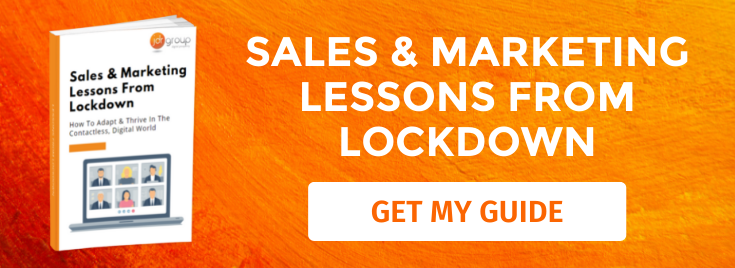Here's How Inbound Marketing Can Help Your Manufacturing Business Grow
by Leanne Mordue on 21-Dec-2022 13:00:00

Inbound Marketing is a strategic approach to marketing that focuses on creating and delivering valuable content to attract, engage, and convert customers. At each stage of the buyer journey, the customer makes the ‘inbound’ moves – the supplier’s job is to provide the appropriate content to address customer questions at each stage and to nurture each lead to the point where they are ready to instigate a sales enquiry. Inbound marketing uses digital content to lay the foundations for solid, profitable, and enduring customer relationships – built on trust and credibility.
Manufacturing Businesses Can Benefit From Inbound Marketing In Several Key Ways:
- By producing engaging content that attracts visitors to your website you can generate more leads and sales.
- Inbound marketing can help you build trust and credibility with potential and current customers, developing your reputation as an industry leader.
- Inbound marketing can improve your search rankings, helping you reach more potential customers online by broadening your profile with important keywords and search phrases.
If you’re looking for a way to grow your manufacturing business using online channels, inbound marketing is a scalable solution that can be adapted to any budget and all levels of growth targets.
What Steps Are Involved In An Inbound Marketing Campaign?
Step 1: Research Your Audience And Target Market
The first step in any inbound marketing campaign is to research your audience and target market. This step is crucial and underpins all others because it will help you determine what kind of content to create, what topics and messages to use, and how best to reach your target market.
When researching your audience, you should consider defining characteristics like their demographics (age, gender, location, etc.), their interests and needs, and what kind of problems they are trying to solve. These factors all play a role in the buyer’s approach to products and services and the challenges that they may face at work, while also shining a light on the best means of reaching this person through their favoured online channels.
Step 2: Develop A Buyer Persona
A buyer persona is a semi-fictional representation of your ideal customer based on the research you conducted in Step One.
Buyer personas are important because they enable you to create content that appeals directly to your target market. We recommend creating a buyer persona document for each type of person you regularly talk to in your sales process – e.g., SME business owners, finance directors, procurement managers, senior engineers etc.
Some businesses may have one primary persona, whereas others may deal with several. When creating your personas, think of the challenges or pain points they face and how your products and services provide a solution to these. Other questions to address include where the persona usually goes to research information, common sales objections, and how they would resolve their challenges if they didn’t purchase your products and services. This information will enable you to tailor a sales-optimised value proposition and a series of marketing messages to address questions at every stage of the persona’s buyer journey.
Step 3: Create Engaging Content
Now that you know who your target market is and what kind of problems they are trying to solve, it’s time to start creating engaging content that speaks directly to them. Some ideas for content you can create include blog posts, infographics, eBooks, white papers, case studies, email newsletters, webinars, and more. Your buyer persona research will advise you on the best types of content to use and where to publish it.
What distinguishes inbound marketing content from general-purpose content, however, is its purpose. A marketing blog article isn’t simply a blog post written to fill space, for example, it is a digital sales asset designed to make you money. Marketing content is tailored to a specific buyer persona and is intended to encourage a certain action. This could be an appeal to make a direct sales enquiry, or it could be a prompt to research more about a certain topic, subscribe to an email newsletter or YouTube video channel, or so on. Every aspect of your inbound marketing content should be optimised to fulfil its stated purpose and be closely monitored to assess its relative success or failure.
Step 4: Distribute Your Content
You’ve invested in high-powered content marketing assets. Now you need to publish them in the appropriate places to draw the attention of your target personas. This step is critical because if no one sees your content then it won’t matter how good it is—it won’t do anything for your business. You can either distribute your content internally on your website or business blog and then optimise it for visibility through SEO, and/or you can leverage social media platforms like LinkedIn, Facebook, and Twitter. Other distribution channels include email marketing campaigns; paid advertising/pay-per-click; guest blogging; and more.
Step 5: Analyse Your Results And Adjust Your Strategy
Inbound content marketing is not a fire-and-forget strategy. The final and ongoing step in any inbound marketing campaign is analysing the results of your efforts so far and adjusting your strategy to fine-tune and improve your results. Using a marketing analytics platform gives you real-world insights into the performance of each digital asset by letting you see the number of clicks and visits, your bounce rate, social shares, and other points of engagement.
When analysing the results of your inbound campaign, there are a few key metrics you should pay special attention to such as website traffic statistics (how many people are visiting your website), conversion rates (how many people are taking the desired action), leads generated (how many new leads have come in), sales generated (how much new revenue has been generated), cost per lead (how much money did it take to acquire each new lead), cost per sale (how much money did it take to acquire each new sale), and overall ROI (return on investment).
Understanding these metrics lets you see which approach works the best with your target audience, which keywords yield the most leads and sales, and which messages, if any, fall flat with your audience. You may be surprised at what you discover once you start analysing your content.
Marketing Services For Manufacturers
JDR Group delivers a range of inbound marketing services to help Manufacturing SMEs grow their customer base online. To discuss your growth plans or to find out more about inbound marketing, please call one of our experienced marketing team today on 01332 343281.
Image Source: Pexels
- Inbound Marketing (SEO, PPC, Social Media, Video) (823)
- Strategy (361)
- Sales & CRM (193)
- Marketing Automation & Email Marketing (190)
- Business Growth (162)
- Website Design (160)
- Hubspot (137)
- Lead Generation (115)
- Google Adwords (98)
- Content Marketing (94)
- Conversion (48)
- Case Studies (47)
- News (47)
- Ecommerce (39)
- Webinars (34)
- SEO (24)
- AI (19)
- Events (19)
- Video (17)
- LinkedIn Advertising (15)
- Video Selling (15)
- Software training (13)
- Niche business marketing (11)
- The Digital Prosperity Podcast (10)
- Facebook Advertising (6)
- HubSpot Case Studies (5)
- December 2025 (7)
- November 2025 (6)
- October 2025 (17)
- September 2025 (16)
- August 2025 (14)
- July 2025 (14)
- June 2025 (5)
- May 2025 (19)
- April 2025 (15)
- March 2025 (13)
- February 2025 (13)
- January 2025 (8)
- December 2024 (2)
- November 2024 (4)
- October 2024 (21)
- September 2024 (4)
- August 2024 (8)
- July 2024 (14)
- June 2024 (16)
- May 2024 (25)
- April 2024 (15)
- March 2024 (18)
- February 2024 (5)
- January 2024 (10)
- December 2023 (6)
- November 2023 (10)
- October 2023 (13)
- September 2023 (12)
- August 2023 (14)
- July 2023 (13)
- June 2023 (14)
- May 2023 (15)
- April 2023 (13)
- March 2023 (14)
- February 2023 (13)
- January 2023 (15)
- December 2022 (13)
- November 2022 (6)
- October 2022 (8)
- September 2022 (22)
- August 2022 (15)
- July 2022 (13)
- June 2022 (16)
- May 2022 (14)
- April 2022 (16)
- March 2022 (17)
- February 2022 (11)
- January 2022 (8)
- December 2021 (6)
- November 2021 (7)
- October 2021 (11)
- September 2021 (10)
- August 2021 (7)
- July 2021 (7)
- June 2021 (4)
- May 2021 (4)
- April 2021 (1)
- March 2021 (3)
- February 2021 (5)
- January 2021 (4)
- December 2020 (7)
- November 2020 (6)
- October 2020 (5)
- September 2020 (9)
- August 2020 (18)
- July 2020 (17)
- June 2020 (17)
- May 2020 (10)
- April 2020 (21)
- March 2020 (24)
- February 2020 (21)
- January 2020 (12)
- December 2019 (23)
- November 2019 (12)
- October 2019 (14)
- September 2019 (16)
- August 2019 (15)
- July 2019 (13)
- June 2019 (6)
- May 2019 (8)
- April 2019 (4)
- March 2019 (2)
- February 2019 (2)
- January 2019 (2)
- December 2018 (3)
- November 2018 (24)
- September 2018 (11)
- August 2018 (9)
- June 2018 (3)
- May 2018 (6)
- April 2018 (14)
- March 2018 (12)
- February 2018 (16)
- January 2018 (15)
- December 2017 (15)
- November 2017 (18)
- October 2017 (23)
- September 2017 (19)
- August 2017 (28)
- July 2017 (27)
- June 2017 (25)
- May 2017 (18)
- April 2017 (17)
- March 2017 (16)
- February 2017 (17)
- January 2017 (14)
- December 2016 (21)
- November 2016 (27)
- October 2016 (25)
- September 2016 (16)
- August 2016 (20)
- July 2016 (19)
- June 2016 (14)
- May 2016 (20)
- April 2016 (24)
- March 2016 (22)
- February 2016 (28)
- January 2016 (27)
- December 2015 (28)
- November 2015 (19)
- October 2015 (9)
- September 2015 (12)
- August 2015 (5)
- July 2015 (1)
- June 2015 (10)
- May 2015 (3)
- April 2015 (11)
- March 2015 (14)
- February 2015 (15)
- January 2015 (12)
- December 2014 (2)
- November 2014 (23)
- October 2014 (2)
- September 2014 (2)
- August 2014 (2)
- July 2014 (2)
- June 2014 (7)
- May 2014 (14)
- April 2014 (14)
- March 2014 (7)
- February 2014 (2)
- January 2014 (7)
- December 2013 (9)
- November 2013 (14)
- October 2013 (17)
- September 2013 (3)
- August 2013 (6)
- July 2013 (8)
- June 2013 (4)
- May 2013 (3)
- April 2013 (6)
- March 2013 (6)
- February 2013 (7)
- January 2013 (5)
- December 2012 (3)
- November 2012 (2)
- September 2012 (1)
Subscribe by email
You May Also Like
These Related Blogs

Inbound Marketing: Finally, Something That Works For Professional Services
We often get asked by business owners of professional services businesses (for example solicitors, accountants, IT services, consultants) the followin …

The 3 Best Types of Content to Create That Generate More Sales for Your Business
Content marketing is a lucrative and effective means of engaging your target buyers, directly addressing their questions and concerns, and generating …

Is your marketing generating enough quality leads for the sales team to convert?
As part of a marketing team/department of a business your role is to get the business noticed by prospects and current customers, to improve business …




